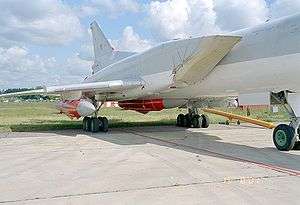Kh-32
Kh-32 (Russian: Х-32) is a Russian supersonic air-launched cruise missile with a range of 600–1000 km developed by the MKB Raduga from the Kh-22. The missile was accepted to service in 2016 as armament for the Tu-22M3M bombers.
| Kh-32 | |
|---|---|
 Tu-22M3 with a Kh-22 missile. Kh-32 shares its hull with its predecessor. | |
| Type | Air-to-surface missile |
| Place of origin | Soviet Union |
| Service history | |
| Used by | Russia |
| Production history | |
| Designer | MKB Raduga |
| Produced | 1990s |
| Specifications | |
Operational range | 600–1,000 km (320–540 nmi) |
| Flight ceiling | 40,000 m |
| Maximum speed | Mach 3.5–Mach 4.6 (4,287.7–5,635.2 km/h; 2,664.2–3,501.6 mph) |
Guidance system | Inertial guidance followed by terminal active radar homing |
Launch platform | Tu-22M3M |
History
Work on the deep modernization of the missile Kh-22 began in the late 80s of the last century, due to the low immunity of its guidance radar operating at fixed frequencies. When the enemy was using radar jamming, the launch of the Kh-22 was impossible.
State contract number 01133 for development work on the topic "Adaptation" was signed in 19 June 1990. Due to the general crisis in the country and insufficient financing, work on the topic was suspended several times. In 1998, the first missile tests were carried out on the basis of the 929th GLITS, and further work was stopped due to lack of funding from the Tupolev Design Bureau for the modernization of the aircraft-carrier.
On 7 March 2008, Contract No. 83042 was signed with the Raduga State Committee for Design and Development for testing prototypes of 9-A-2362 missiles with TK-56 missiles until 25 November 2011. OJSC Tupolev was to re-equip one combat aircraft Tu-22M3 for testing within the framework of the topic Adaptation-45.03M.
Based on the Resolution of the Council of Ministers of Russia No. 1080-31 December 2010 on the state defense order for 2011 and its planned period for 2012–2013, the Tu-22M3 aircraft board No. 9804 / head No. 4898649 as part of the modernization of the Tu-22M3 fleet was reequipped with pilot production of the OKB Design Bureau named after A.N. Tupolev (topic "Potential") for testing air-to-ground missiles 9-A-2362. Flight tests of the aircraft with missiles were conducted at the end of July 2013. Several flights have been completed, including at least one flight with missile launches.
As of August 2016, at Tactical Missile Armament Corporation (which includes MKB Raduga), the research on the product continued. It was also confirmed that the product is in a high degree of technical readiness.
At the end of 2016 the Kh-32 missile officially adopted. Planned modernization of 30 aircraft Tu-22M3 in the Tu-22M3M version.[2][3][4][5]
Design
The main differences from the Kh-22
The Kh-32 missile is made in the Kh-22 case and their geometrical dimensions are completely identical. Due to the reduced warhead increased the volume of tanks. Installed another, more powerful engine. A new interference-free radar inertial guidance system with radio command correction and reference to the terrain (from altimeter) was installed. Instead of autopilot installed automatic control system.[6]
Its maximum range of 1000 kilometers means it can be launched outside the maximum range of US Navy F/A-18 Super Hornets, which have a maximum combat radius of around 720 Kilometers.[4]
Penetration of missile defense systems
Konstantin Sivkov believes that Kh-32 possesses powerful means of breaking through the missile defense system of Aegis Combat System", equipped with Standard Missile 6 missiles, because:[7][6]
- Kh-32 flies to a target with a ceiling of about 40 kilometers, which is 7 km higher than the height of short range US missile defense system;
- He thinks the speed of the Kh-32 is twice the maximum allowed speed of the SM-6 for aerodynamic targets: 1500 vs. 800 meters per second; even though as critics have noted SM-6 has intercepted SRBM, MRBM targets in the atmosphere and both can move at significantly higher speed than Kh-32. Furthermore, USN frequently intercept Mach 4 target drones with a service ceiling of 30 km (AQM-37) in practice
- The Kh-32 on the final stage attacks the target in a steep dive (the standard means of breaking the missile defense against many legacy radars that do not include objects directly above themselves in their viewing angle);
- Multi-frequency radar in Kh-32 has better resistance to EW such as spot jamming
Performance specifications
Presentation of the performance characteristics in the version of Konstantin Sivkov[7][6]
- Carrier – Tu-22M3M
- 3.5–4.6 Mach (from 4000 to 5600 kilometers per hour or 1100–1500 meters per second)
- Starting range – 600–1000 km
- The range of capture by radar – 200–300 km (when starting from a longer range requires external target designation of the approximate area of the presence of the target to capture it).
- Maximum flight altitude – 40 000 m
Sources and literature
- Karpenko A.V. BTS "Bastion".
- "Aviation and Astronautics". – 1996. – № 5.
References
- "Russia will arm itself with the invulnerable 'aircraft carrier killer'". lenta.ru. Retrieved 15 May 2018.
- Litovkin, Nikolai; RBTH (30 August 2016). "New Russian cruise missiles to hit targets from the stratosphere". www.rbth.com. Retrieved 23 January 2019.
- Lockie, Alex. "Russia upgraded a nuclear bomber â€" and its missiles are a nightmare for US Navy aircraft carriers". Business Insider. Retrieved 23 January 2019.
- Diplomat, Franz-Stefan Gady, The. "Russia's Upgraded Tu-22M3M Long-Range Bomber to Make Maiden Flight in August". The Diplomat. Retrieved 23 January 2019.
- "Unnoticed troubler peace of mind | Military Industrial Courier weekly". vpk-news.ru. Retrieved 22 March 2018.
- "The Russian "Kitchen" was called invulnerable to American missiles". Retrieved 22 March 2018.